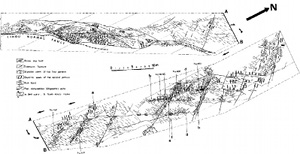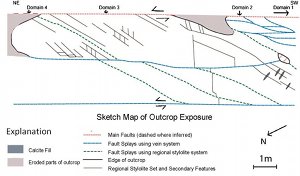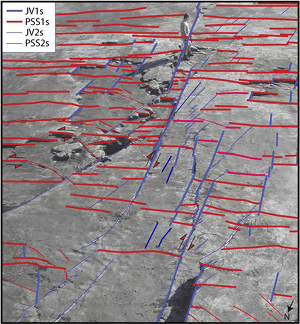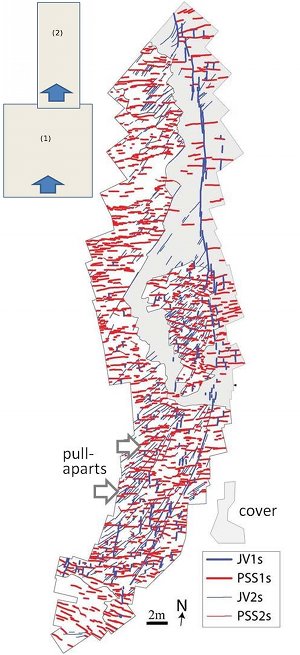|
The presence of PSS domains has been known from measurements of orientations and qualitative descriptions of field patterns of pressure solution seams (see for example, Alvarez et al., 1978; Mardon, 1988). However, it has not been a topic of strong interest to a degree that patterns of the domains and their variation were precisely documented. Here are some examples: Figure 1 and Figure 2 from Petit and Mattahauer (1995) and Watkinson and Ward (2006) from the Les Matelles limestone outcrops in the Languedoc region of France.
 | | Figure 1. Distribution of multiple sets of pressure solution seams and veins associated with a series of strike-slip faults in a micritic limestone outcrop in the Languedoc region near Montpellier, France. From Petit and Mattauer (1995). |
 | | Figure 2. Sketch showing domains of pressure solution seam and vein sets in micritic limestone outcrop at the Les Matelles, France. From Watkinson and Ward (2006). |
Figure 3 and Figure 4 are maps showing variable PSS patterns in sandstone in response to primarily contractional deformation and faulting in County Clare, southwest Ireland (Nenna and Aydin, 2011). Clearly in both cases shearing of either earlier pressure solution seams or veins played a crucial role. Other examples will be described and analyzed under 'Faulting based on Shearing of Initial Weaknesses' and 'Assemblages of Joints / Veins and Pressure Solution Seams.'
 | | Figure 3. Patterns of pressure solution seams and veins in sandstone, Ross platform, southwestern Ireland. From Nenna and Aydin (2011). |
 | | Figure 4. Map of the southern end of the southernmost sheared vein segment in Figure 1 showing a complex interplay between the splay veins (JV1), sheared pressure solution seams (PSS1), and splay pressure solution seams (PSS2). Arrows point out two of numerous pull-aparts such as those shown in Figure 3. From Nenna and Aydin (2011). |
| |
Alvarez, W. , Engelder, T., Geiser, P.A., 1978. Classification of solution cleavage in pelagic Limestones. Geology 6 (5): 263-266.
Mardon, D., 1988. Localized pressure solution and the formation of discrete solution seams. Ph.D. thesis, College Station, Texas A and M University, Texas, USA.
Nenna, F., Aydin, A., 2011. The role of pressure solution seam and joint assemblages in the formation of strike-slip and thrust faults in a compressive tectonic setting; the Variscan of southwestern Ireland. Journal of Structural Geology 33: 1595-1610, doi:10.1016/ j.jsg.2011.09.003.
Petit, J.P., Mattauer, M., 1995. Palaeostress superimposition deduced from mesoscale structures in limestone: the Matelles exposure, Languedoc, France. Journal of Structural Geology 17 (2): 245-256.
Watkinson, A.J., Ward, E.M.G., 2006. Reactivation of pressure-solution seams by a strike-slip fault-sequential, dilational jog formation and fluid flow. American Association of Petroleum Geologists Bulletin 90 (8): 1187–1200.
|



